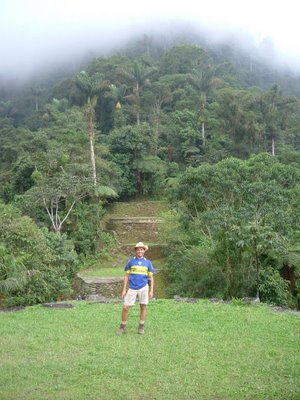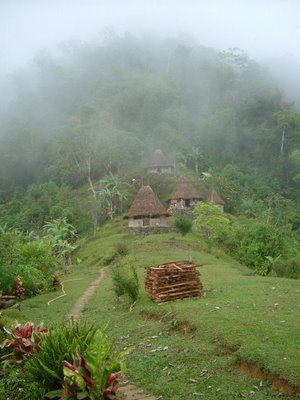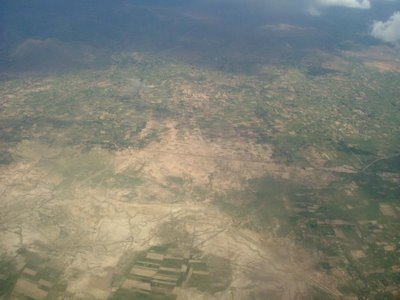
Where else around the world can you go on a trek that includes : a lost city deep in the rain forest, a cocaine production facility, a village of indigenous people, and a free stash of marijuana ?

The
Ciudad Perdida, lost city, is a six day trek, three to get there and three to come back, the city is only reachable by foot, neither cars nor mules can get there, the group I went was contained eleven people from different countries, Max and Kayla from California, Michel from Germany, Mel and Hal from England, Genny from Australia, Enrique from Spain, Chris from England, and Stewart and Helen from England, eleven in total, after meeting at the
Miramar hotel, we head out in a
Chiva, a traditional Colombian bus, that used to be the popular mean of transport in Colombia, it was replaced by modern buses and now only used as touristic gimmick, we were dropped at village were we had launch, and from there our trek started, not before the guide handed us a bag of Marijuana.

The lost city became infamous a few years ago when a group of tourists on a similar trek, were kidnapped by
FARC gorillas, the trek was conducted by the same company I went with,
Turcol, there was a big group of tourists plus some guides, including the son of the owner of the company, who managed to untie himself and others and run back to town to tell the story, the gorillas took only part of the hostages, the ones who though were most capable of enduring long hard walks, as the Gorillas tend to stay on the move all the time, eight were taken, four Israelis, two English, one German and one Spaniard, one of the Britons managed to escape, the rebels did not want any money for them, they just wanted attention and publicity for their cause, and eventually released all the hostages, after some extensive negotiations, first the German and Spaniard, then the other Briton and the Israelis, after more than three month in captivity, lately there have been little conflict around this area, as the
FARC were driven out, and the Paramilitaries now control it.

The first day we had to walk three hours to get to the camp site, run by a family, on the way we saw a few Coca fields, at the campsite we went for a swim in the river, in a nearby natural pool, then we had dinner and slept in hammocks covered by mosquito nets. The next morning we were introduced to the owner of a cocaine production facility, and offered a tour for 30000 pesos each, which we managed to negotiate down to 20000 (about 8 Euros), everybody in the group went on the tour, the facility was a 20 minutes walk away, hidden in the thick rain forest, it was rather modest, low tech facility run by one man, there was a yard full of coca leaves and a lot of barrels containing all kinds of chemicals.

Then we got a demonstration of the process, first the Coca leaves are grounded and mixed with salt and plaster (building material), one kilogram of Coca leaves produces approximately one gram of pure cocaine, then the mix is stamped over until it gets a dark color, then it is mixed with benzine, 120 Litres if benzine for 100 Kilos of Coca leaves, the Benzine extracts the cocaine from the leaves, then 8 litres of water and 8 spoons of sulfuric acid are added, which absorb the cocaine from the Benzine, in the process 20 Litres of benzine is lost, absorbed by the leaves, but the rest can be reused again, then I kind of lost track of things, there is some more chemicals added, potassium hydrate and acids, then the liquid is stirred and filtered, and finally a white paste is produced, only one more step is required to finish the process, and get pure cocaine, but it requires
aciton which he does not have, so he sells the paste to the big cocaine fab close by, for 6 million pesos per kilo (2200 Euros), at the big fab the last step of the process that includes using
aciton is done, and the pure cocaine is send to the cost were it is loaded on boats and exported, at the some point the cocaine is diluted with other white powders, by as much as half or third. the US government is financing a scheme here, a scheme that offers farmers 600,000 pesos per two month, in return to stopping growing Coca and producing cocaine, but not many take the offer as it is more profitable to them to make the cocaine.

There are several reasons why the owner does not have
aciton, first it is a substance that is desired by the gorillas, as it can be used to make explosives, and they will steal it if they find it, so the Paramilitaries forbade the farmers to have it, the other reason is if the farmers have Cocaine they might start taking it them selves, which apparently happened a while back, this threatened to destroy some families, and caused violence and murders, as coke addicts tried to steal coke from other farmers, the Paramilitaries decided to put an end to it, adjourned a meeting, and threatened to kill anybody who will take the stuff himself, according to the guide, some were killed by the Paramilitaries, but by controlling
aciton the Paramilitaries can prevent the farmers from producing the pure cocaine, and it also forces them to the sell them the cocaine paste. Although generally it is the
FARC who are blamed for the cocaine export from Colombia, it seems that the Paramilitaries, who support the Colombian
goverment and army, are just as involved, they protect and control the cocaine production and export from the region.

After the cocaine tour, we continued our path toward the lost city, we were told that the weather was still dry, but this is generally the time when the rainy season starts, and apparently our trek coincided with the start of the rains, it was generally dry in the morning, but it rained every afternoon, and usually continued through the night, anything that got wet remained wet, sometimes I managed to dry a thing or two by hanging them by the fire place. The second camp site was near a river as well, and we went for a swim before it started to rain, somebody pulled out a Spanish Scrabble card game, which became a big hit. The food in general was quite good, but the quality went down later during the trip as less fresh ingredients remained. One of the guides, Jose, apparently likes to sing and compose
Valleneto songs (a local and very popular music), and he entertained us during the nights, with just his voice and a drum.

The next day we continued our path, and reached a village of the
Cogi, group of indigenous people still living in their traditional way, in huts made of wood and straw, and wearing traditional clothes, I split my snicker bar, and divided it between a few children.

It is thought that the
Cogi are the descendants of the
Tyaronas who build the lost city, they are nomads, and the little village is only used as site to perform traditional ceremonies, they take place in the big round hut, where only men are allowed, they gather there, chew coca leaves, take hallucination drugs made from sea shells, and can stay there for days, "debating solutions for their problems". Walking further we encountered areas of cleared forest, this deforstation apparently started in the last few years, the land is planted is used for one rice crop, then once the grass had grown it is used as pastors for cattle.

Next we descended to the valley, walking along the river for a while, crossing from one bank to the other several times in the process, finally we reached the stairway leading to the lost city, a stairway containing about 1250 steps.

The lost city is located in a clearing on top of a hill, surrounded by mountain tops, similar to the
Machu Picchu, the city was discovered in 1975 by grave robbers, or treasure hunters to use more kind terminology, apparently the owner of the
Cocain facility is a grave robber when he is not making cocaine, anyway a new surge of artifacts sold in the black market of Santa Marta aroused the suspicious of the governor, who found out about the city, and send an expedition to discover it, during the next few years, the city which was completely covered by the forest, was gradually exposed, many of the artifacts ended up in museums, like the gold museum in Bogota, some stolen by the archaeologists and other people who worked on the excavation, if you believe my guide. Unfortunately the process was never completed as the governor was reluctant to further fund the study, the opposition of the
Cogi was another factor, big parts of the city are still covered by forest. Unlike the Inca, the
Tayronas used wood for building there houses, so the only remains of the city are the stairways and the round terraces, on which the houses were build over.

The
Tayrona culture was basically destroyed by the Spanish, who coveted their gold, in the process they killed, violated and enslaved the
Tayrona people, exterminating there civilization, the Spanish guy in the group was target for many of the jokes of the guides, anyway the lost city was abandoned at the time, maybe people fled in fear that the Spanish will find them, but another reason might by that they lost there trading relations with the
Tayronas of the cost, and they depended on that trade for obtaining essential goods, like salt, fish and sea shells, this caused them diseases as essential ingredients were missing from their diets, anyway the Spanish never found the lost city, and the city remained
unlooted until found by the grave robbers in 1975. We camped at the city that night, then had a tour of the city in the morning, the area around the city is very green, and the views are amazing, after that we headed back.

A couple of people on the tour wanted to take an alternative route back, which is more scenic but is longer, steeper and harder, most of the group decided to join them, so I decided to join them as well, more for the company than anything else, eight people ended taking the alternative route back, we paid 60000 extra each. After descending from the lost city, we had a very steep climb, followed by a steep and slippery downhill path, which got even more slippery as the regular afternoon rain started coming down, after that it was another steep climb up, until the camp site were we had launch, there was a debate then whether to continue the next camp site, or camp the night there and wake up very early in the morning, the group decided on the later, mainly because the camp site was very nice, and because the mornings are generally dry, while the afternoons are quite wet, after dinner we went to sleep very early.

The next morning we woke up at 4:30, but it was still dark, so we could not start walking, so I went back to bed, trying to get a little bit more sleep, we headed out before six, after having only a cup of coffee, the other had a banana as well, but I missed on that since I was sleeping, we had to start early to make sure we catch the only transport leaving to Santa Marta, from one of the villages near by, we passed by a place called paradise, but we really could not judge
whether it was a paradise or not, as it was completely shrouded in fog, we walked more than three hours before reaching the next camp site, where we finally had hour breakfast,
empanadas of tuna, courtesy of our great chef, it was supposed to be only a two hour walk until having breakfast, but telling the truth seems to be a something that our guide, Alavaro, has a lot of difficulties with. Another hour an half of walking was need to reach the village, for a change this day was sunny, and we finally managed to enjoy the spectacular land scape that this route offers, definitely more spectacular than the route we came by.

Our transport was a truck with a roofed back, which seemed more suitable for transporting cattle than humans, the road was very bumpy in the beginning, and it seemed that the truck was going to fall apart anytime, this truck is the only transport the people of this area have, and we stopped every once in a while to pick up people, it
took three and half hours to reach Santa Marta.

























